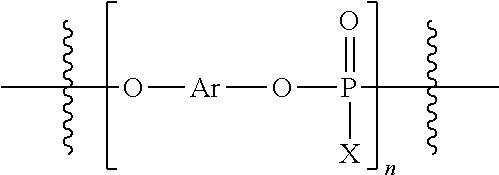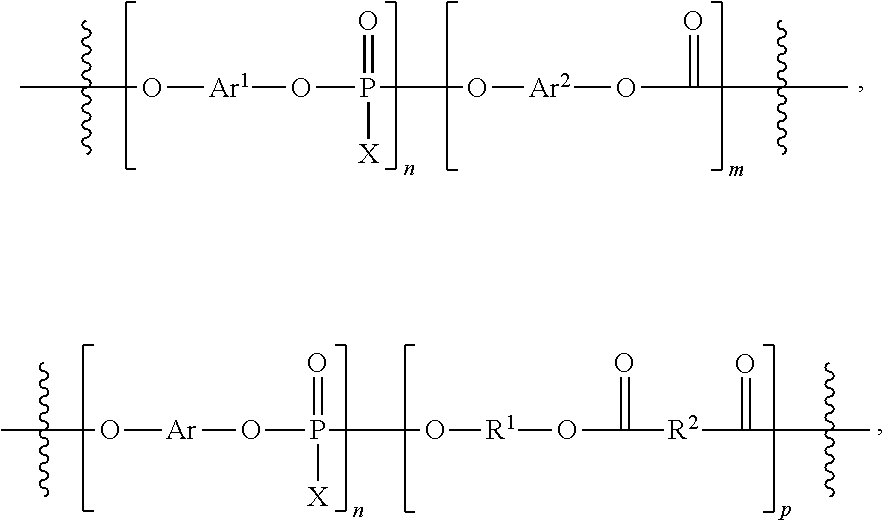Phosphonate polymers, copolymers, and their respective oligomers as flame retardants for polyester fibers
a technology of phosphonate polymers and copolymers, which is applied in the direction of rigid containers, monocomponent polyester artificial filaments, floating buildings, etc., can solve the problem of extreme difficulty in imparting fire resistance to polyester fibers
- Summary
- Abstract
- Description
- Claims
- Application Information
AI Technical Summary
Benefits of technology
Problems solved by technology
Method used
Image
Examples
example 1
Preparation of Polyester Mixtures:
[0038]Poly(ethylene terephthalate) (PET, solution viscosity 0.62 dL / g) was melt mixed with polyphosphonate having a molecular weight of 100,000 g / mole (PS standards) to produce PET / phosphonate blends having phosphonate polymer loading levels ranging from 2.5% to 15% by weight. These blends where then spun into fibers. Each of the PET / polyphosphonate blends exhibited excellent processability and melt spinning produced 5 to 8 denier fibers and 18 to 22 denier fibers using the same production equipment used for pure PET fibers. Fibers then underwent heat setting and exhibited excellent heat-setting characteristics. Table 1 gives a description of each of the samples tested.
TABLE 1Composition of textile samplesSampleDescriptionControl #1Commercial PET with fire retardant (FR)Control #2PET, No FRControl #3PET, No FRFRX-100@ 2.5% in PET2.5% phosphonate polymerFRX-100@ 5% in PET5% phosphonate polymerFRX-100@ 10% in PET10% phosphonate polymerFRX-100@ 15% in ...
example 2
Flame Resistance Testing
[0039]The fibers described in Table 1 were tested according to ASTM 701 and exhibited good fire resistant behavior. Fabric samples woven from these compositions were tested according to ASTM D6413-99 “Standard Test Method for Flame Resistance of Textiles” with a slight modification in the procedure in that the samples were not conditioned before testing. Specifically, test samples were cut into 3 inches by 12 inches samples that were vertically mounted 0.75 inches above the flame burner. The flame had a height of 1.5 inches, and the sample was exposed to a flame for 12 seconds. The char length was determined after a weight of 200 g (tearing force) was attached to one edge of the burnt sample, and the opposite end was raised in a smooth continuous motion until the tearing force was supported by the sample. A minimum of three repeats were performed on each sample composition. The results are presented in Table 2.
TABLE 2Flame Resistance Testing of Textile Compos...
example 3
Flame Persistence Testing:
[0041]PET / polyphosphonate fibers were prepared as described in Example 1 were fabricated into circular knitted fabric specimens. The fabric specimens were fabricated from a false-twisted PET yarn (130, dtex (225), f 38 bright-3.5 dtex / filament). Washing, drying and conditioning of all specimens was conducted according to ISO 6330 (2000-2008), using washing procedure 5A. The flame persistence test was conducted according to NF P 92-504 (1995) with some deviations from the standard due to the small sample size. The results from this test on several formulations are provided in Table 3.
TABLE 3Flame Persistence Test ResultsAfter Flame Time, secondsTestControlNumber(Virgin PET)FRX 2.5%FRX 5.0%FRX 7.5%FRX 10.0%140****2*****3215***420*3**5N / T****6N / T****7N / T5***8N / T****9N / T****10 N / T3*3*FlamingYesNoNoNoNoDebrisNon-NoYesYesNoYesFlamingDebrisN / T = not tested* = afterflame time was less than 2 seconds
[0042]The test results in Table 3 show the superior fire resistant ...
PUM
| Property | Measurement | Unit |
|---|---|---|
| Linear density | aaaaa | aaaaa |
| Linear density | aaaaa | aaaaa |
| Diameter | aaaaa | aaaaa |
Abstract
Description
Claims
Application Information
 Login to View More
Login to View More - R&D
- Intellectual Property
- Life Sciences
- Materials
- Tech Scout
- Unparalleled Data Quality
- Higher Quality Content
- 60% Fewer Hallucinations
Browse by: Latest US Patents, China's latest patents, Technical Efficacy Thesaurus, Application Domain, Technology Topic, Popular Technical Reports.
© 2025 PatSnap. All rights reserved.Legal|Privacy policy|Modern Slavery Act Transparency Statement|Sitemap|About US| Contact US: help@patsnap.com



